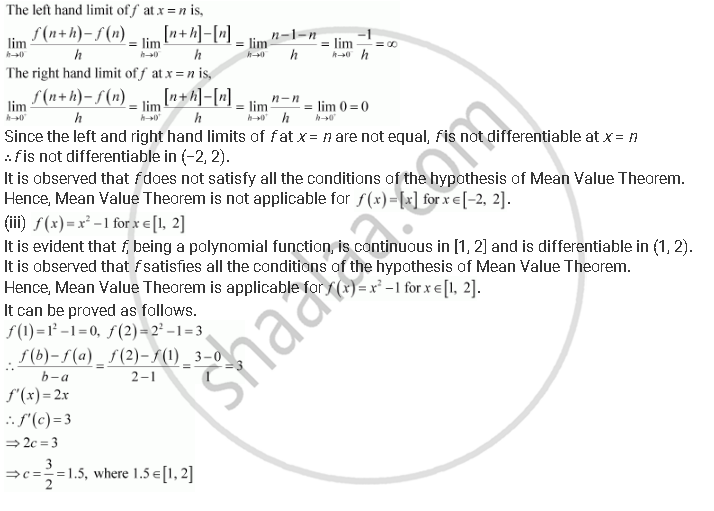Advertisements
Advertisements
प्रश्न
Examine the applicability of Mean Value Theorem for all three functions given in the above exercise 2.
उत्तर
Mean Value Theorem states that for a function f:[a,b] -> R, if
(a) f is continuous on [a, b]
(b) f is differentiable on (a, b)

ii) f (x) = [x] for x ∈ [– 2, 2]
It is evident that the given function f (x) is not continuous at every integral point.
In particular, f(x) is not continuous at x = −2 and x = 2
⇒ f (x) is not continuous in [−2, 2].
The differentiability of f in (−2, 2) is checked as follows.
Let n be an integer such that n ∈ (−2, 2).

APPEARS IN
संबंधित प्रश्न
Verify Lagrange’s mean value theorem for the function f(x)=x+1/x, x ∈ [1, 3]
Verify Rolle's theorem for the function
f(x)=x2-5x+9 on [1,4]
Check whether the conditions of Rolle’s theorem are satisfied by the function
f (x) = (x - 1) (x - 2) (x - 3), x ∈ [1, 3]
Verify Rolle’s theorem for the function f (x) = x2 + 2x – 8, x ∈ [– 4, 2].
Examine if Rolle’s Theorem is applicable to any of the following functions. Can you say some thing about the converse of Rolle’s Theorem from these examples?
f (x) = [x] for x ∈ [5, 9]
Examine if Rolle’s Theorem is applicable to any of the following functions. Can you say some thing about the converse of Rolle’s Theorem from these examples?
f (x) = x2 – 1 for x ∈ [1, 2]
If f : [– 5, 5] → R is a differentiable function and if f ′(x) does not vanish anywhere, then prove that f (– 5) ≠ f (5).
Verify Mean Value Theorem, if f (x) = x2 – 4x – 3 in the interval [a, b], where a = 1 and b = 4.
Verify Rolle’s theorem for the following function:
f (x) = x2 - 4x + 10 on [0, 4]
Verify Rolle’s theorem for the following function:
`f(x) = e^(-x) sinx " on" [0, pi]`
Verify Lagrange's Mean Value Theorem for the following function:
`f(x ) = 2 sin x + sin 2x " on " [0, pi]`
f(x) = (x-1)(x-2)(x-3) , x ε[0,4], find if 'c' LMVT can be applied
Verify the Lagrange’s mean value theorem for the function:
`f(x)=x + 1/x ` in the interval [1, 3]
Verify Rolle’s theorem for the function, f(x) = sin 2x in `[0, pi/2]`.
f(x) = `sin^4x + cos^4x` in `[0, pi/2]`
Discuss the applicability of Rolle’s theorem on the function given by f(x) = `{{:(x^2 + 1",", "if" 0 ≤ x ≤ 1),(3 - x",", "if" 1 ≤ x ≤ 2):}`
Find the points on the curve y = (cosx – 1) in [0, 2π], where the tangent is parallel to x-axis
Using Rolle’s theorem, find the point on the curve y = x(x – 4), x ∈ [0, 4], where the tangent is parallel to x-axis
f(x) = `1/(4x - 1)` in [1, 4]
f(x) = `sqrt(25 - x^2)` in [1, 5]
Find a point on the curve y = (x – 3)2, where the tangent is parallel to the chord joining the points (3, 0) and (4, 1)
The value of c in Rolle’s theorem for the function f(x) = x3 – 3x in the interval `[0, sqrt(3)]` is ______.
Rolle’s theorem is applicable for the function f(x) = |x – 1| in [0, 2].
The value of c in Rolle’s theorem for the function, f(x) = sin 2x in `[0, pi/2]` is ____________.
The value of c in mean value theorem for the function f(x) = (x - 3)(x - 6)(x - 9) in [3, 5] is ____________.
If the greatest height attained by a projectile be equal to the horizontal range, then the angle of projection is
Let a function f: R→R be defined as
f(x) = `{(sinx - e^x",", if x < 0),(a + [-x]",", if 0 < x < 1),(2x - b",", if x > 1):}`
where [x] is the greatest integer less than or equal to x. If f is continuous on R, then (a + b) is equal to ______.
P(x) be a polynomial satisfying P(x) – 2P'(x) = 3x3 – 27x2 + 38x + 1.
If function
f(x) = `{{:((P^n(x) + 18)/6, x ≠ π/2),(sin^-1(ab) + cos^-1(a + b - 3ab), x = π/2):}`
is continuous at x = ` π/2`, then (a + b) is equal to ______.
`lim_(x→0) sqrt(1 - cosx)/(sqrt(2)x)` is ______.
Let f(1) = –2 and f'(x) ≥ 4.2 for 1 ≤ x ≤ 6. The possible value of f(6) lies in the interval ______.
